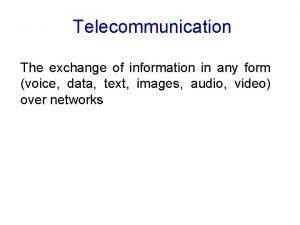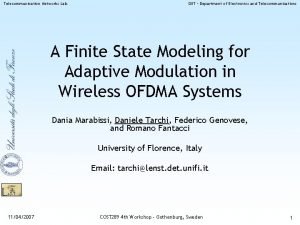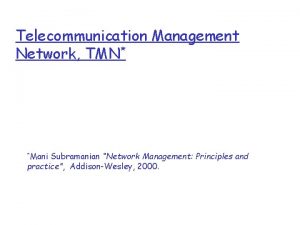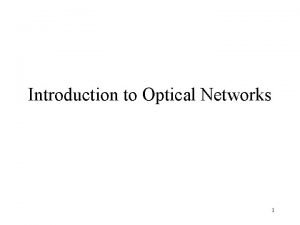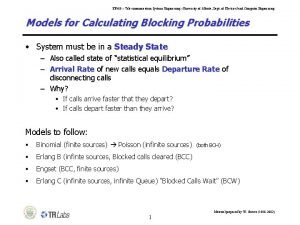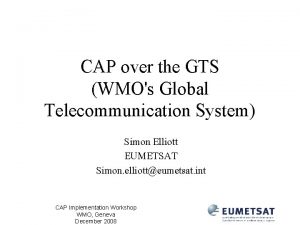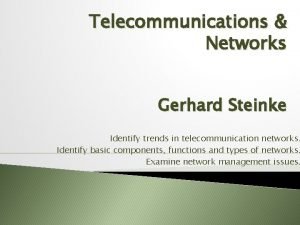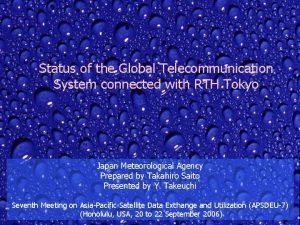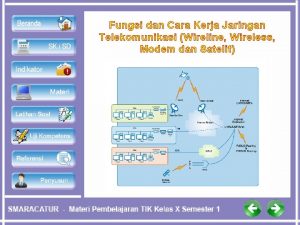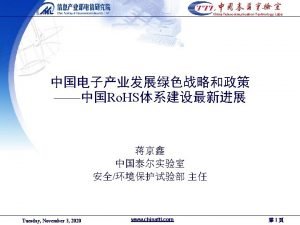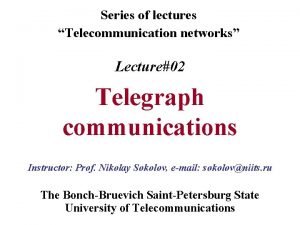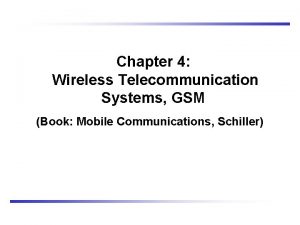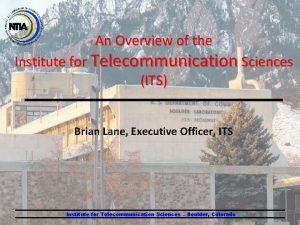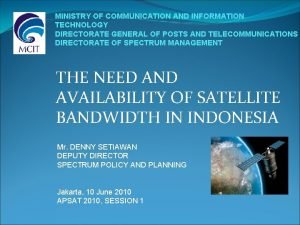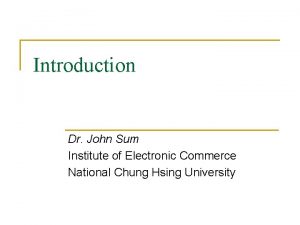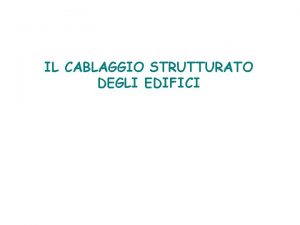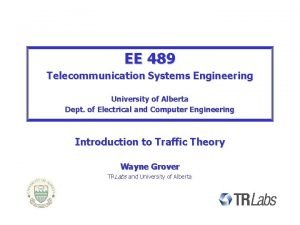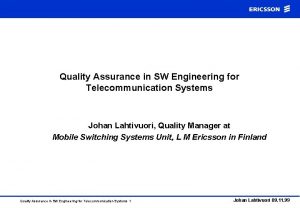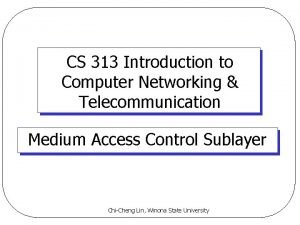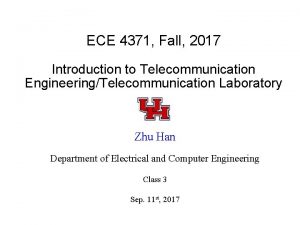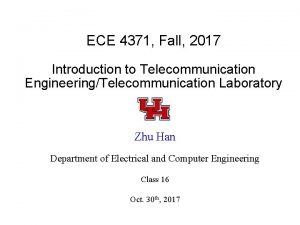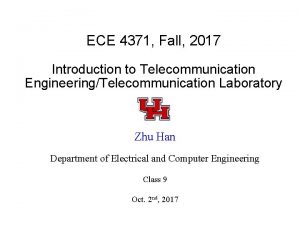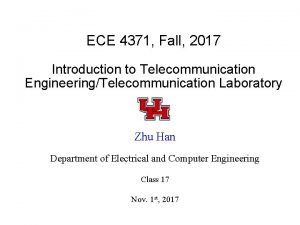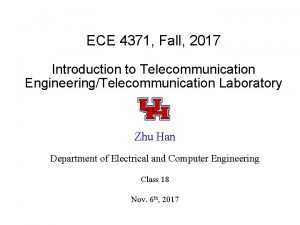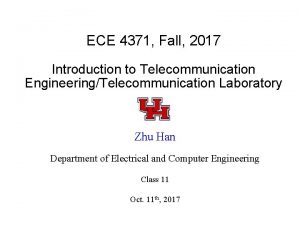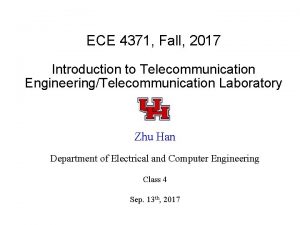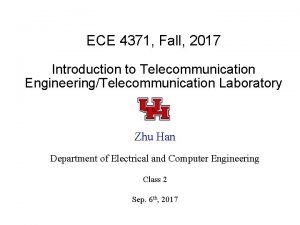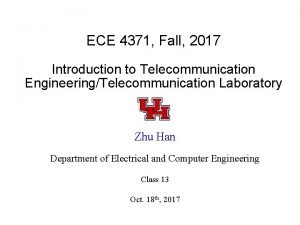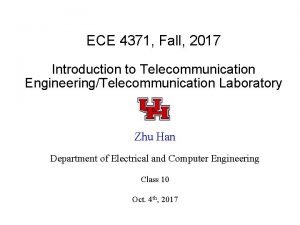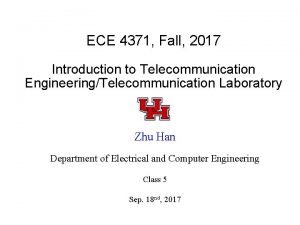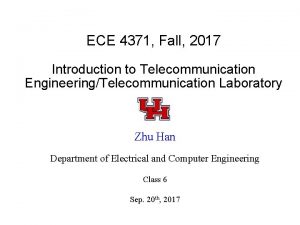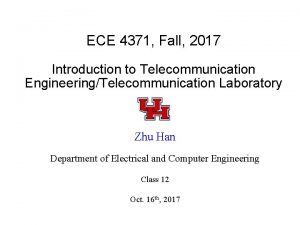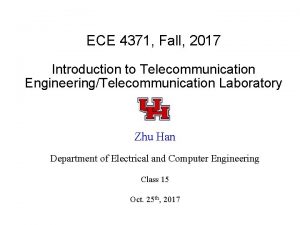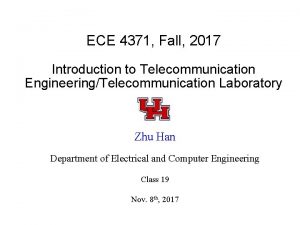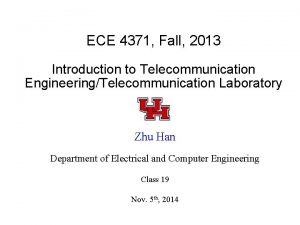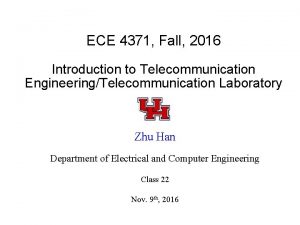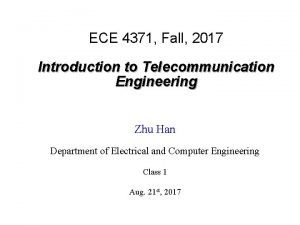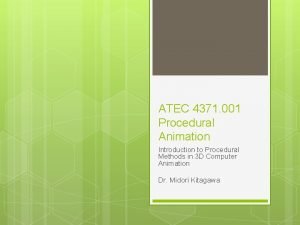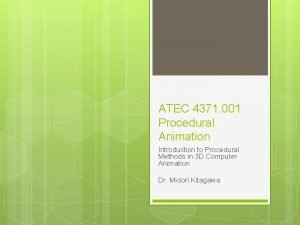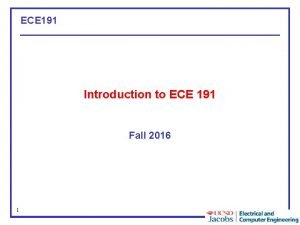ECE 4371 Fall 2017 Introduction to Telecommunication EngineeringTelecommunication



































- Slides: 35

ECE 4371, Fall, 2017 Introduction to Telecommunication Engineering/Telecommunication Laboratory Zhu Han Department of Electrical and Computer Engineering Class 7 Sep. 25 nd, 2017

Outline l Review of sampling theorem – Sample frequency 2 times more than that of sampled signal – Time and frequency interpretation – Anti-aliasing filter l PAM/PWM/PPM/PCM l Quantization – – SNR vs. quantization level Two optimal rules VQ quantization A law/u law l Practical ADC/DAC l Delta Modulation

PAM, PWM, PPM, PCM

Quantization l Scalar Quantizer Block Diagram l Mid-tread l Mid-rise

Equations

Quantization Noise

Quantization Noise Level

Quantization SNR , 6 d. B per bit

Example l SNR for varying number of representation levels for sinusoidal modulation 1. 8+6 X d. B Number of Bits representation level L per Sample, R SNR (d. B) 32 5 31. 8 64 6 37. 8 128 7 43. 8 256 8 49. 8

Conditions for Optimality of Scalar Quantizers Let m(t) be a message signal drawn from a stationary process M(t) -A m A m 1= -A m. L+1=A mk mk+1 for k=1, 2, …. , L The kth partition cell is defined as Jk: mk< m mk+1 for k=1, 2, …. , L d(m, vk): distortion measure for using vk to represent values inside Jk.

Condition for Optimal Quantizer

Condition One

Condition Two

Vector Quantization image and voice compression, voice recognition statistical pattern recognition volume rendering

Rate Distortion Curve l Rate: How many codewords (bits) are used? Distortion – Example: 16 -bit audio vs. 8 bit PCM speech l Distortion: How much distortion is introduced? – Example: mean absolute difference(L 1), mean square error (L 2) l Vector Quantizer often performs better than Scalar Quantizer with the cost of complexity SQ VQ Rate (bps)

Non-uniform Quantization Motivation – Speech signals have the characteristic that smallamplitude samples occur more frequently than large-amplitude ones – Human auditory system exhibits a logarithmic sensitivity l u u More sensitive at smallamplitude range (e. g. , 0 might sound different from 0. 1) Less sensitive at largeamplitude range (e. g. , 0. 7 might not sound different much from 0. 8) histogram of typical speech signals

Non-uniform Quantizer F: nonlinear compressing function F-1: nonlinear expanding function F and F-1: nonlinear compander y F x Example F: y=log(x) Q ^ y F-1 ^ x F-1: x=exp(x) We will study nonuniform quantization by PCM example next A law and law EE 541/451 Fall 2006

Law/A Law l The -law algorithm (μ-law) is a companding algorithm, primarily used in the digital telecommunication systems of North America and Japan. Its purpose is to reduce the dynamic range of an audio signal. In the analog domain, this can increase the signal to noise ratio achieved during transmission, and in the digital domain, it can reduce the quantization error (hence increasing signal to quantization noise ratio). l A-law algorithm used in the rest of worlds. l A-law algorithm provides a slightly larger dynamic range than the mu-law at the cost of worse proportional distortion for small signals. By convention, A-law is used for an international connection if at least one country uses it.

Law

A Law

Law/A Law Example 6. 2 and 6. 3

Analog to Digital Converter l Main characteristics – Resolution and Dynamic range : how many bits – Conversion time and Bandwidth: sampling rate l Linearity – Integral – Differential l Different types – – Successive approximation Slope integration Flash ADC Sigma Delta

Successive approximation l Compare the signal with an n-bit DAC output l Change the code until – DAC output = ADC input l An n-bit conversion requires n steps l Requires a Start and an End signals l Typical conversion time – 1 to 50 s l Typical resolution – 8 to 12 bits l Cost – 15 to 600 CHF

Single slope integration l Start to charge a capacitor at constant current l Count clock ticks during this time l Stop when the capacitor voltage reaches the input l Cannot reach high resolution Vin Counting time – capacitor – comparator Start Conversion C IN + Q R Oscillator Enable Counter - S Clk N-bit Output

Flash ADC l Direct measurement with 2 n-1 comparators l Typical performance: – 4 to 10 -12 bits – 15 to 300 MHz – High power Half-Flash ADC – 2 -step technique l u u u l 1 st flash conversion with 1/2 the precision Subtracted with a DAC New flash conversion Waveform digitizing applications

Sigma-Delta ADC

Over-sampling ADC l Hence it is possible to increase the resolution by increasing the sampling frequency and filtering l Reason is the noise level reduce by over sampling. l Example : – an 8 -bit ADC becomes a 9 -bit ADC with an over-sampling factor of 4 – But the 8 -bit ADC must meet the linearity requirement of a 9 -bit

Resolution/Throughput Rate

Digital to Analog Converter l Pulse Width Modulator DAC l Delta-Sigma DAC l Binary Weighted DAC l R-2 R Ladder DAC l Thermometer coded DAC l Segmented DAC l Hybrid DAC

Delta Modulation (DM)

DM System: Transmitter and Receiver.

Slope overload distortion and granular noise The modulator consists of a comparator, a quantizer, and an accumulator. The output of the accumulator is

Slope Overload Distortion and Granular Noise ( differentiator )

Delta-Sigma modulation (sigma-delta modulation) The modulation which has an integrator can relieve the draw back of delta modulation (differentiator) Beneficial effects of using integrator: 1. Pre-emphasize the low-frequency content 2. Increase correlation between adjacent samples (reduce the variance of the error signal at the quantizer input ) 3. Simplify receiver design Because the transmitter has an integrator , the receiver consists simply of a low-pass filter. (The differentiator in the conventional DM receiver is cancelled by the integrator )

delta-sigma modulation system.
 What is telecommunication network
What is telecommunication network 2017 dvhimss annual fall conference
2017 dvhimss annual fall conference Telecommunications project management
Telecommunications project management Objectives of telecommunication
Objectives of telecommunication Types of telecommunication networks
Types of telecommunication networks Telecommunication and data communication
Telecommunication and data communication Kyushu telecommunication network co.,inc.
Kyushu telecommunication network co.,inc. Telecommunication
Telecommunication Telecommunication management network
Telecommunication management network Swift finance retrievals
Swift finance retrievals Telecommunication network architecture
Telecommunication network architecture Telecommunication
Telecommunication Global telecommunication system
Global telecommunication system Telecommunication trends
Telecommunication trends Global telecommunication system
Global telecommunication system Itu world telecommunication indicators database
Itu world telecommunication indicators database Kelebihan dan kekurangan jaringan wireline
Kelebihan dan kekurangan jaringan wireline China telecommunication technology labs
China telecommunication technology labs Telecommunication
Telecommunication Telecommunication sealing technology
Telecommunication sealing technology Bsc and msc in telecom
Bsc and msc in telecom Institute for telecommunication sciences
Institute for telecommunication sciences World telecommunication standardization assembly
World telecommunication standardization assembly Ministry of telecommunication
Ministry of telecommunication Types of telecommunication
Types of telecommunication Telecommunication
Telecommunication Cablaggio strutturato degli edifici
Cablaggio strutturato degli edifici University of alberta
University of alberta Shervin erfani
Shervin erfani Umos msu
Umos msu Telecommunication system architecture with diagram
Telecommunication system architecture with diagram Quality control in telecommunication
Quality control in telecommunication Alcatel lucent
Alcatel lucent Telecommunications for dummies
Telecommunications for dummies Telecommunication medium
Telecommunication medium China telecommunication technology labs
China telecommunication technology labs




